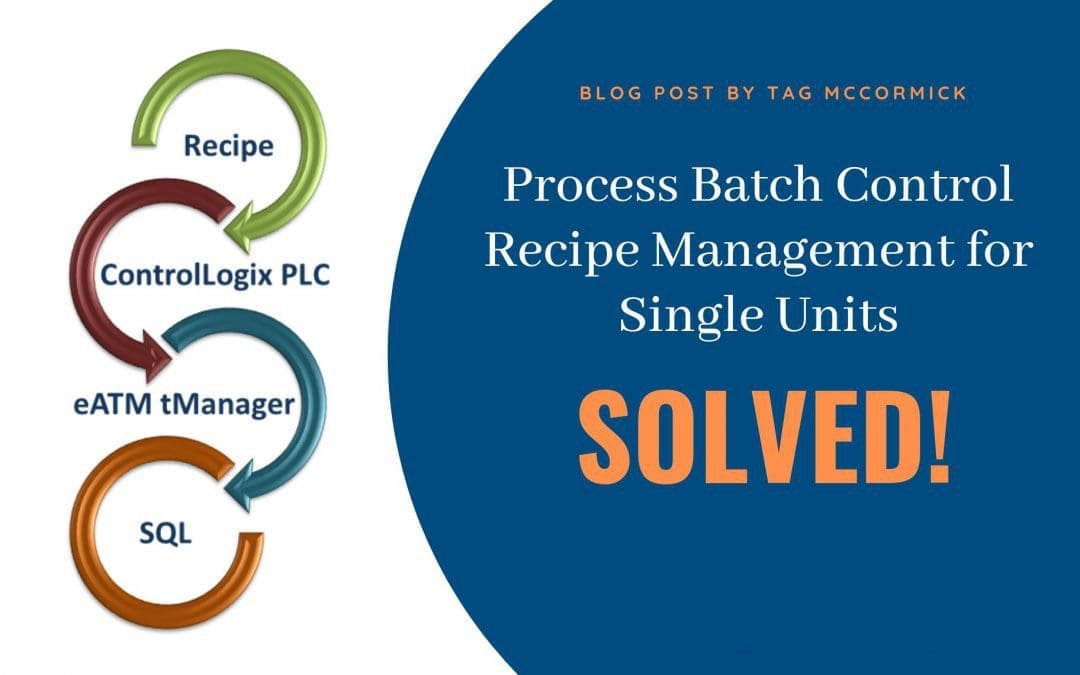
Blog post by Tag McCormick, E Tech Group Project Manager
Recipe management is a complex process even in the most basic configuration, like a single tank, bioreactor or Clean in Place (CIP) skid. Plenty of solutions currently exist on the market for large-scale batch management (batch engines), which are intended for use by an entire facility. But what should control engineers use when recipe management is needed only on a small scale, such as for a single unit? Softing, a Rockwell Automation Encompass Product Partner, has solved this common problem with the 56eATM-TMGR module.
The Dilemma of Small-Scale Automated Recipe Batch Management
Traditionally in this situation, design engineers were forced to make a decision from three available choices:
- Engineers could use a full-scale batch management system, but this choice is costly and overkill for a single-unit system.
- Engineers could choose custom scripts executed by the Supervisory Control and Data Acquisition (SCADA) computer to interact with a database or “flat” log file stored locally on the computer. The downside to this approach is that custom scripts are hard to maintain/modify/understand, and log files are not secure.
- Design engineers could use the Programmable Logic Controller (PLC) to store recipes, but significant issues exist with this choice as well. Data storage space is fixed, not dynamic; recipes are susceptible to unintended modification and can lack an audit trail, and PLCs are great at repeatable execution of logic, but are not intended to store large amounts of data.
These solutions all fall short of an elegant, efficient solution to single-unit batch management. That’s where Softing’s tManager comes in.
Softing’s Solution: Dedicated Small-Scale Automation Control
The Softing 56eATM-TMGR module enables an efficient design of recipe management for single units. Recently, E Tech Group implemented a module for a pharmaceutical process CIP skid. The platform was Rockwell Automation ControlLogix with Microsoft SQL. The Softing tManager module was installed in the chassis (rack) as a stand-alone device that manages the interaction with a database (Microsoft SQL).
The Softing tManager uses each component of the system to its best advantage and for its intended use. The SCADA computer interacts with users and the PLC; the PLC runs the recipe-based unit procedure; and the SQL database stores the recipe. To manage the transfer of information, the Softing tManager module handles the exchange of recipe data between the PLC and SQL.
Adding in Microsoft SQL creates additional benefits, such as built-in functions for creating secure and storable unique IDs, and date/timestamps for database table entries. In SQL, the database table size is dynamic – rows are added by SQL as required, so the storage is limited by the available space on the computer hosting SQL. Note that even a small computer hard drive has many times the storage of a PLC memory chip.
The Right Tools: In Automation, the Simplest Solution can Lighten the Load
Controls engineers can run into issues when trying to convince the client that the Softing tManager module solution is the most efficient way to control recipes in a single unit. Common misconceptions are that a full-blown batch control engine is needed, or that recipes should be handled in the PLC. Sometimes the issue is that customers are unaware that there is a technology available to accommodate just this situation, questioning that such a “mystery module” exists to interact directly with SQL.
The possible solutions for a single-unit batch system are many, but this is a case of using the right tool for the job. An automation solution intended for large scale (many and/or distributed units) can be cumbersome when applied to small scale (single local unit). On the other hand, fully custom solutions can be difficult to develop, test and troubleshoot, and may not ever achieve the functionality of a configurable solution.
Important Things to Consider with Softing’s tManager Module
The following questions can help engineers decide if the Softing 56eATM-TMGR module is the appropriate technology for the process:
- Do you need to configure recipes, store the configurations in a secure place, and easily retrieve/load them in a PLC to be run?
- Do you want to avoid a full-scale batch engine solution?
- Do you want to avoid a fully-custom solution?
This technology is an important tool for controls engineers because of its ability to simplify solutions for single-unit systems. Superior Controls uses a hybrid approach that strikes a good balance for single-unit systems:
- The module does the work – a piece of hardware with easy-to-use configuration software made specifically to transfer data between PLCs (Rockwell Automation’s ControlLogix) and databases (Microsoft SQL).
- A small amount of scripting in the SCADA system for interface with the user (not the heavy lifting of SQL transactions) allows for some customizability for user requirements.
- The module leverages all the built-in security and robustness of SQL for managing data.
For more information on effective automation solutions for batch control processes large or small, contact us.
